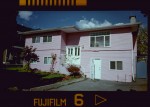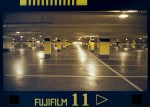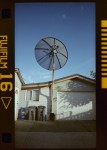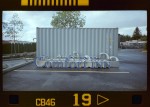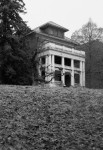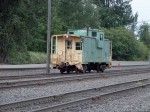Jan
7
2016

 The defining feature of this camera has to be that 38-180mm focal length lens. A lens that I might point out has an aperture of f12.9 at the long end. Doing a little math in the form of a word problem.
The defining feature of this camera has to be that 38-180mm focal length lens. A lens that I might point out has an aperture of f12.9 at the long end. Doing a little math in the form of a word problem.
Q: On a nice clear day Little Suzy has a Canon Z180 loaded with 400 ASA film and wants to take a picture of her friend Phil who is off in the distance on the edge of the woods looking like a hipster lumberjack. If Suzy zooms to 180mm how much motion blur will the picture have?
A: As Phil is in the shade of the woods and has a dark beard the light is likely to be around EV 11 so the camera would select a shutter speed of around 1/60 of a second or about 2 stops too slow for that focal length on 35mm film resulting in just enough blur to make you say ‘Ugggg where is my digital camera and is that a squirrel attacking Phils face’
I also don’t think that the focusing is quite up to the zoom factor of the lens as it seems to miss focus more than less ambitious zoom models.
One thing about one camera: You can set the flash to always be off through this simple method. With the camera off hold down the timer button then press the flash button, CF 1-0 will show on the LCD (That’s custom function 1 – off) press the zoom in button once to select CF 2-0 now press the flash button to set it to CF 2-1 (Custom function 2 – on) , turn the camera on to finish the setting. Now when you turn the camera off it will remember the shooting and flash mode so you can disable the flash and keep it that way. Super easy, Ugggg where is my digital camera?
no comments | tags: 35mm, camera, Canon, film, point and shoot | posted in Cameras, Photography
Jan
21
2015

Lets be honest the only appealing thing about this camera is the fact that it has a 26mm lens which sets it apart from almost all the other point and shoot cameras in the world (including ones in the landfill).
One of the side effects of Canon’s attempt to produce this wideangle wonder was that the corners of the image are so soft that you could stuff a pillow with them.

But is it bad enough to make it good? Not really, 26mm doesnt provide a distinct advantage over the more available 28mm camera’s that I’ve seen and the results are questionable but not bad enough to make it obvious that you ment to do it. The flash doesn’t cover the frame very well and without it it heavily under exposes in darker situations. The focus is fixed as is the aperture at f6. The viewfinder is nice and big though I will give it that.

What I’ve rambled on about this camera before previously Canon BF-10
no comments | tags: camera, Canon, film, wide angle | posted in Cameras, Photography
Jan
6
2015

It has been awhile since I pulled out the Canon WP-1. It’s not the first camera I think of when it comes to fitting in but that’s not true if your going to the beach there it is right at home. It’s toy like appearance hides the fact that it has a fantastic 32mm f3.5 lens. 32mm as I’ve said before sits nicely between 28 and 35mm really giving the best of both worlds just like the Pentax UC1. The big controls designed to be used with gloves or underwater are great and the viewfinder is big and because it is designed to be used with a snorkel mask allows you to hold it away from your eye when composing which is a nice change from the jam it against your face and try to find the light through the tunnel view of many cameras.
I’ve written previously about the camera and those posts can be seen here Canon Wp-1 search
1 comment | tags: camera, Canon, film | posted in Cameras, Photography
Dec
22
2014

Having found a way of scanning my APS film that produced good quality images it only stands to reason that I would find a worse way to do it, after all it is APS film. Okay this is easier to do its just that the results aren’t as good. This is a cheap film scanner of the type you find in a business supply store or at a garage sale or laying on the side of the road. This one has the ability to pull the film through it without cutting and that is the key to how this works. Although the holder is designed for 35mm film the smaller APS film can be kept square against one edge. Unfortunately it gives an image that looks like it was shot with a cheap 3 Megapixel camera. On the positive side again the image is already converted from a negative and only requires cropping. Ultimately despite the greater effort required I think I will revert to my macro lens flash system.

I shot these images with the impossibly small Canon Elph LT more from this camera here Canon Elph LT

no comments | tags: APS, Canon, film | posted in Cameras, Photography, Processing
May
29
2014

There is plenty of information available about the Canon AE-1 so I won’t spend too much valuable photography time writing about it but I will say that it leaves something to be desired in terms of ease of use. My primary complaint being the lack of any feedback in the viewfinder (in manual mode) as to what the camera is set to. Also the lack of exposure compensation beyond a hard to locate +1.5 EV backlight compensation button make it less versatile than other similar SLR’s from that time even a basic Pentax K1000 using metered manual is easier.
Used in shutter priority mode which is really its native setting it’s fine and the viewfinder is big and bright. There are many FD lenses available with the 50mm 1.4 being a great example and reason enough to shoot with this camera if you are willing to take the time to adjust to it’s controls.
no comments | tags: Canon, film | posted in Cameras, Photography
Sep
15
2013
This is a mix of images from either the Canon G2 or the Canon Sure Shot Classic 120. I compared the two cameras outputs in Digital vs Film 2001 edition. I cropped the film images to match the aspect ratio of the digital cameras 1.333x 1 to make distinguishing the two a little harder. At these sizes it’s not always obvious which is which. I did my first exploration for the difference between film and digital in a post here The battle of 2001 and came to a similar conclusion so I will move forward in time next to see if I can find that illusive moment when digital photography exceeded film in its abilities for the average photographer free of all the marketing.
1 comment | tags: Canon, Digital, film | posted in Photography, Processing
Sep
12
2013

Previously I looked for the point at which digital image capture exceeded film for the average snap shot Film vs Digital the battle of 2001. This time around I’ve chosen two different cameras available in 2001 both higher quality and with zoom lenses.
The two cameras are the 4.1 Mpixel Canon G2 with its 1/1.8″ CCD sensor and 34-102mm (35mm equivalent) f2.0 – F8.0 lens against films Canon Sure Shot Classic 120 and its 7 element super Spectra coated f4.5 -f10.9 lens using Kodak Ektar 100. I shot the Canon G2 set at 100 ISO through out.
The Sure Shot Classic 120 was released in 1999 and the Canon G2 came out in 2001 but seeing as film cameras age far more gracefully than digital cameras I think it’s a pretty good comparison, besides there were not many more film cameras being developed at that point.
Looking at the images as the same size side by side it is immediately apparent that for web-based or small prints up to 5×7 there is little difference between them although the Ektar turns out to be less grainy. I think it would be more evenly matched if I had used a lower grade film like Fuji Superia.


It’s only when you look at printing larger sizes that it become apparent that film has the clear advantage.

Another thing that isn’t readily apparent is the fact that I had to slightly adjust the exposure a lot with the Canon G2 to prevent it from clipping the highlights something I couldn’t do with the film camera but was completely unnecessary anyway. All through this film has the advantage in dynamic range. The example bellow is without any compensation in a very high contrast situation.

As for colour the digital camera rendered them more naturally.


Conclusion
In 2001 even at about 3 times the cost digital point and shoot cameras did not yet exceed film cameras of the same type and I havent even touched on the issue of speed of operation where the G2 is about as fast taking a picture as the Classic 120 is rewinding a roll of film. That’s an exaggeration but from the time you turn the G2 on till you can take a picture is nearly 6 seconds plus about 2.5 to zoom plus 1 second to focus so you better plan ahead in the past.
I will post a gallery of images from the two cameras in a future post maybe mixing them up between the two cameras.
3 comments | tags: Cameras, Canon, Digital, film | posted in Cameras, Photography
May
12
2013


Released in 2000 the Canon Z90W (Autoboy Epo) has a 28-90mm f4.5-9.9 lens which is slow at the telephoto end but the quality of the optical system overall is quite good. Being from 2000 its just new enough to find internet reviews from the time the camera was released. The best part of this camera is the large mode dial on the back, with 7 different positions, the most interesting to me being ‘Personal’ which lets me configure the flash to be off at all times. This is done be selecting Personal on the dial and then pressing the mode button then using the zoom buttons to toggle through the available flash choices; Auto,Red eye,Flash on,Flash off,+1.5 exposure comp.,-1.5 exposure comp., and slow sync flash.
Of the point and shoot film cameras with zoom lenses that go down to 28mm this is the best. Used at the 28mm wide end it compares well with fixed focal length film compacts.
5 comments | tags: camera, Canon, film | posted in Cameras, Photography
Mar
18
2013

Forged in the fires of Mordor this camera rules them all…oops apparently this isn’t that kind of elfin camera and its plastic would melt quicker than butter on a hobbits scone. What it is though is diminutive and equipped with a nice 26mm f2.8 prime lens. This hobbit sized APS camera is small enough that you can even forget it’s in a pocket. Like most cameras of its time control only goes as far as turning the flash off and I’ve discovered it doesn’t focus well when you put it up against a chain link fence ( there are two examples of that in the pictures they should be easy to spot). It’s almost hard to say if the lens is better than the zoom of the original Elph because APS film is just awful, it is the great equalizer. The specifications for the lens though are 32.5mm focal length equivalent in terms of 35mm film and 4 elements in 4 groups one of them an aspherical element so I’m going to say its better than the film would suggest.
2 comments | tags: APS, Canon, film | posted in Cameras, Photography
Jan
5
2013

What can I say, I like shooting in the rain or at least not worrying that my camera gear will be damaged by it. I’ve seen pictures taken with this camera completely submerged but Canon did not actually claim that this was an underwater camera despite the obviously robust sealing. In fact the WP stands for water proof which is what you expect when you’re talking about a jacket not something to be dunked. The manual even states “This camera is designed to be water proof and can be used in the rain or splashed with water with no ill effects. However this is not an underwater camera.” So user beware.  I really like the control dial although I’m not sure why the subject needs to see it instead of the photographer. I do suspect it is a necessary engineering decision considering that you need to open the back to put film in. With the dial you can turn the camera on and disable the flash in one operation which is a bonus as I rarely want to use the flash built into these compact cameras. It is also a very quiet camera in all it’s operations which only slightly counteracts its garish appearance.
I really like the control dial although I’m not sure why the subject needs to see it instead of the photographer. I do suspect it is a necessary engineering decision considering that you need to open the back to put film in. With the dial you can turn the camera on and disable the flash in one operation which is a bonus as I rarely want to use the flash built into these compact cameras. It is also a very quiet camera in all it’s operations which only slightly counteracts its garish appearance.
My previous thoughts on this camera “Fred Herzog and the Canon WP-1“
2 comments | tags: camera, Canon, film | posted in Photography

 The defining feature of this camera has to be that 38-180mm focal length lens. A lens that I might point out has an aperture of f12.9 at the long end. Doing a little math in the form of a word problem.
The defining feature of this camera has to be that 38-180mm focal length lens. A lens that I might point out has an aperture of f12.9 at the long end. Doing a little math in the form of a word problem.




























































